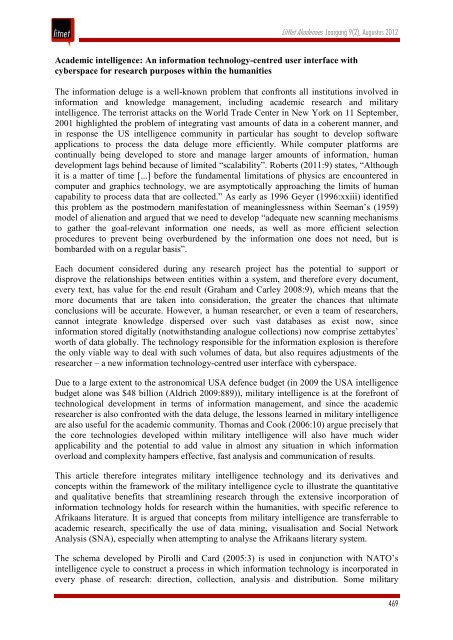Klik hier om die artikel in PDF-formaat - LitNet
Klik hier om die artikel in PDF-formaat - LitNet
Klik hier om die artikel in PDF-formaat - LitNet
You also want an ePaper? Increase the reach of your titles
YUMPU automatically turns print PDFs into web optimized ePapers that Google loves.
<strong>LitNet</strong> Akademies Jaargang 9(2), Augustus 2012<br />
Academic <strong>in</strong>telligence: An <strong>in</strong>formation technology-centred user <strong>in</strong>terface with<br />
cyberspace for research purposes with<strong>in</strong> the humanities<br />
The <strong>in</strong>formation deluge is a well-known problem that confronts all <strong>in</strong>stitutions <strong>in</strong>volved <strong>in</strong><br />
<strong>in</strong>formation and knowledge management, <strong>in</strong>clud<strong>in</strong>g academic research and military<br />
<strong>in</strong>telligence. The terrorist attacks on the World Trade Center <strong>in</strong> New York on 11 September,<br />
2001 highlighted the problem of <strong>in</strong>tegrat<strong>in</strong>g vast amounts of data <strong>in</strong> a coherent manner, and<br />
<strong>in</strong> response the US <strong>in</strong>telligence c<strong>om</strong>munity <strong>in</strong> particular has sought to develop software<br />
applications to process the data deluge more efficiently. While c<strong>om</strong>puter platforms are<br />
cont<strong>in</strong>ually be<strong>in</strong>g developed to store and manage larger amounts of <strong>in</strong>formation, human<br />
development lags beh<strong>in</strong>d because of limited “scalability”. Roberts (2011:9) states, “Although<br />
it is a matter of time [...] before the fundamental limitations of physics are encountered <strong>in</strong><br />
c<strong>om</strong>puter and graphics technology, we are asymptotically approach<strong>in</strong>g the limits of human<br />
capability to process data that are collected.” As early as 1996 Geyer (1996:xxiii) identified<br />
this problem as the postmodern manifestation of mean<strong>in</strong>glessness with<strong>in</strong> Seeman’s (1959)<br />
model of alienation and argued that we need to develop “adequate new scann<strong>in</strong>g mechanisms<br />
to gather the goal-relevant <strong>in</strong>formation one needs, as well as more efficient selection<br />
procedures to prevent be<strong>in</strong>g overburdened by the <strong>in</strong>formation one does not need, but is<br />
b<strong>om</strong>barded with on a regular basis”.<br />
Each document considered dur<strong>in</strong>g any research project has the potential to support or<br />
disprove the relationships between entities with<strong>in</strong> a system, and therefore every document,<br />
every text, has value for the end result (Graham and Carley 2008:9), which means that the<br />
more documents that are taken <strong>in</strong>to consideration, the greater the chances that ultimate<br />
conclusions will be accurate. However, a human researcher, or even a team of researchers,<br />
cannot <strong>in</strong>tegrate knowledge dispersed over such vast databases as exist now, s<strong>in</strong>ce<br />
<strong>in</strong>formation stored digitally (notwithstand<strong>in</strong>g analogue collections) now c<strong>om</strong>prise zettabytes’<br />
worth of data globally. The technology responsible for the <strong>in</strong>formation explosion is therefore<br />
the only viable way to deal with such volumes of data, but also requires adjustments of the<br />
researcher – a new <strong>in</strong>formation technology-centred user <strong>in</strong>terface with cyberspace.<br />
Due to a large extent to the astron<strong>om</strong>ical USA defence budget (<strong>in</strong> 2009 the USA <strong>in</strong>telligence<br />
budget alone was $48 billion (Aldrich 2009:889)), military <strong>in</strong>telligence is at the forefront of<br />
technological development <strong>in</strong> terms of <strong>in</strong>formation management, and s<strong>in</strong>ce the academic<br />
researcher is also confronted with the data deluge, the lessons learned <strong>in</strong> military <strong>in</strong>telligence<br />
are also useful for the academic c<strong>om</strong>munity. Th<strong>om</strong>as and Cook (2006:10) argue precisely that<br />
the core technologies developed with<strong>in</strong> military <strong>in</strong>telligence will also have much wider<br />
applicability and the potential to add value <strong>in</strong> almost any situation <strong>in</strong> which <strong>in</strong>formation<br />
overload and c<strong>om</strong>plexity hampers effective, fast analysis and c<strong>om</strong>munication of results.<br />
This article therefore <strong>in</strong>tegrates military <strong>in</strong>telligence technology and its derivatives and<br />
concepts with<strong>in</strong> the framework of the military <strong>in</strong>telligence cycle to illustrate the quantitative<br />
and qualitative benefits that streaml<strong>in</strong><strong>in</strong>g research through the extensive <strong>in</strong>corporation of<br />
<strong>in</strong>formation technology holds for research with<strong>in</strong> the humanities, with specific reference to<br />
Afrikaans literature. It is argued that concepts fr<strong>om</strong> military <strong>in</strong>telligence are transferrable to<br />
academic research, specifically the use of data m<strong>in</strong><strong>in</strong>g, visualisation and Social Network<br />
Analysis (SNA), especially when attempt<strong>in</strong>g to analyse the Afrikaans literary system.<br />
The schema developed by Pirolli and Card (2005:3) is used <strong>in</strong> conjunction with NATO’s<br />
<strong>in</strong>telligence cycle to construct a process <strong>in</strong> which <strong>in</strong>formation technology is <strong>in</strong>corporated <strong>in</strong><br />
every phase of research: direction, collection, analysis and distribution. S<strong>om</strong>e military<br />
469
















